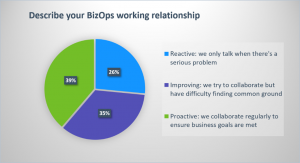One of the more immediate challenges IT organizations face is understanding the business impact of IT service quality. In fact, for most of us, tying application performance to business outcomes has become a priority, requiring us to expand our focus on observability to include business metrics.
To introduce the video part of this blog, here’s a (short) story about silos; does this one sound familiar?
You get a call from a business partner claiming users are abandoning the purchase funnel (or quote form, or payment journey, or event registration) at an alarming rate. This has been going on for a couple days, and it’s threatening to impact monthly conversion numbers.
You look at a handful of open Dynatrace problem cards for the app–but which one is causing the business issue? What do you tell your business partner? “Let me check; if I find something interesting, I’ll let you know” may not be the best answer.
The cost of observability silos
There are multiple villains in the full version of this story; I’ll name four.
- Dr. Delay. It took the business team over 24 hours to understand how critical the problem was before they decided to call IT. How much did that cost?
- Ms. Misdirection. While poor performance or errors can certainly cause a drop in conversions, so can other factors. What if the real culprit were an underperforming ad campaign or confusing messaging?
- Victor Vague. Through a business lens, affected users may be segmented by loyalty status or abandoned cart value, while affected pages often have names that don’t align to the URLs as IT sees them. Who will translate the problem description to match ITs view of the world?
- Good-intentioned IT. Pressure to correct a problem without understanding cause and effect often results in poor prioritization and ineffective results. How will you know if your efforts have achieved the desired business outcome?
The story can–and often does–have a much different ending.

With Dynatrace Business Analytics, you know in real-time when business KPIs–conversions, quotes, payments, registrations, purchases, etc.–degrade. You know how user experience, app performance, errors, and new features or releases impact these KPIs. You have a common view of business metrics–including page names and audience segments–through a shared business lens. You can even have Davis, our AI engine, alert you to business anomalies and identify the root cause for you.
Business analytics: the foundation for collaboration
Effective BizOps collaboration begins with Dynatrace Business Analytics. By connecting application performance and user experience to business KPIs, IT can prioritize resources and investments that most effectively deliver the desired business outcomes. And the opportunity is significant, as highlighted by the following survey.
A recent informal poll from our Perform 21 event found the majority of BizOps collaboration efforts are ineffective or non-existent, while most of those who claim effective collaboration have incorporated business analytics into their IT operations. Below is the survey summary.

What’s your BizDevOps working relationship? Is your organization’s story filled with villains or heroes? What would it mean to rewrite that story?
And now, the video…
In this short video below–Connecting IT metrics to business KPIs–I offer some practical approaches to BizOps collaboration. These include use case design, metric sources, and metadata categories–with the goal of helping you envision the benefits for your organization.

Want to learn more?
Check out our Business Analytics page to see how Dynatrace can help you, and have a read of some of our business analytics blogs and customer stories, or request a demo.
If you’re ready to see business analytics in action, your account team can coordinate a proof of concept, you can DIY, or you can have our Expert Services team help build a solution to your custom use cases.



Looking for answers?
Start a new discussion or ask for help in our Q&A forum.
Go to forum